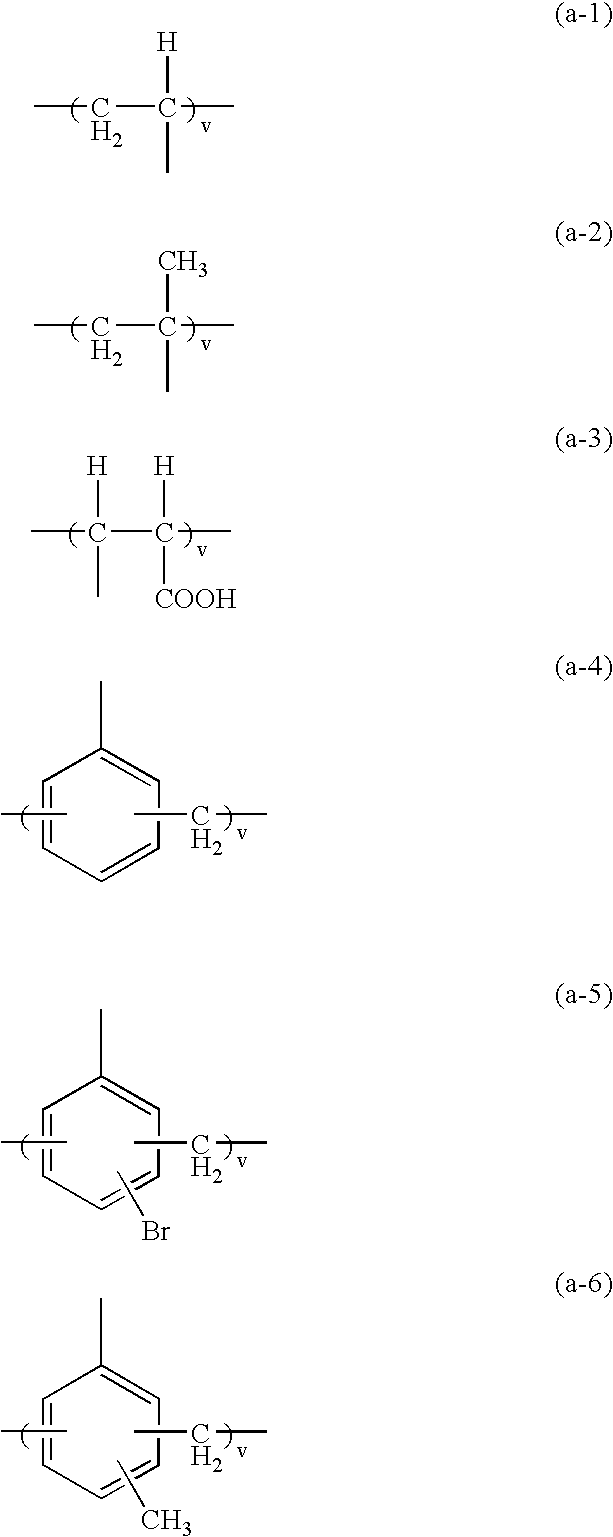Composition for forming anti-reflective coating
a technology of anti-reflective coating and composition, which is applied in the direction of photosensitive materials, instruments, photomechanical equipment, etc., can solve the problems influence of random reflection and standing wave off a substrate, and the research on organic anti-reflective coatings is little known, and the material for organic anti-reflective coatings that achieve such an attenuation coefficient k is little known
- Summary
- Abstract
- Description
- Claims
- Application Information
AI Technical Summary
Problems solved by technology
Method used
Image
Examples
synthesis example 1
Synthesis of Concrete Example [4-1]
[0072] After 13.09 g of 2-bromoethyl methacrylate and 2.44 g of 2-hydroxypropylmethacrylate were dissolved in 54 g of propylene glycol monomethyl ether, the atmosphere was replaced with nitrogen. The resulting solution was warmed to 70° C., and then a solution of 0.47 g of azobisisobutyronitrile dissolved in 10 g of propylene glycol monomethyl ether was added dropwise. The resulting solution was subjected to a reaction under nitrogen atmosphere for 24 hours to obtain a solution of polymer compound of concrete example [4-1]. The resulting polymer compound was subjected to GPC analysis and had a weight average molecular weight (Mw) of 31,000 in terms of standard polystyrene.
synthesis example 2
Synthesis of Concrete Example [4-2]
[0073] After 11.23 g of 2,2,2-tribromoethyl methacrylate and 4.3 g of 2-hydroxypropylmethacrylate were dissolved in 54 g of propylene glycol monomethyl ether, the atmosphere was replaced with nitrogen. The resulting solution was warmed to 70° C., and then a solution of 0.47 g of azobisisobutyronitrile dissolved in 10 g of propylene glycol monomethyl ether was added dropwise. The resulting solution was subjected to a reaction under nitrogen atmosphere for 24 hours to obtain a solution of polymer compound of concrete example [4-2]. The resulting polymer compound was subjected to GPC analysis and had a weight average molecular weight of 22,000 in terms of standard polystyrene.
synthesis example 3
Synthesis of Concrete Example [4-2]
[0074] After 17.72 g of 2,2,2-tribromoethyl methacrylate and 1.7 g of 2-hydroxypropylmethacrylate were dissolved in 70 g of propylene glycol monomethyl ether, the atmosphere was replaced with nitrogen. The resulting solution was warmed to 70° C., and then a solution of 0.58 g of azobisisobutyronitrile dissolved in 10 g of propylene glycol monomethyl ether was added dropwise. The resulting solution was subjected to a reaction under nitrogen atmosphere for 24 hours to obtain a solution of polymer compound of concrete example [4-2]. The resulting polymer compound was subjected to GPC analysis and had a weight average molecular weight of 9,500 in terms of standard polystyrene.
PUM
| Property | Measurement | Unit |
|---|---|---|
| wavelength | aaaaa | aaaaa |
| wavelength | aaaaa | aaaaa |
| wavelength | aaaaa | aaaaa |
Abstract
Description
Claims
Application Information
 Login to View More
Login to View More - R&D
- Intellectual Property
- Life Sciences
- Materials
- Tech Scout
- Unparalleled Data Quality
- Higher Quality Content
- 60% Fewer Hallucinations
Browse by: Latest US Patents, China's latest patents, Technical Efficacy Thesaurus, Application Domain, Technology Topic, Popular Technical Reports.
© 2025 PatSnap. All rights reserved.Legal|Privacy policy|Modern Slavery Act Transparency Statement|Sitemap|About US| Contact US: help@patsnap.com



